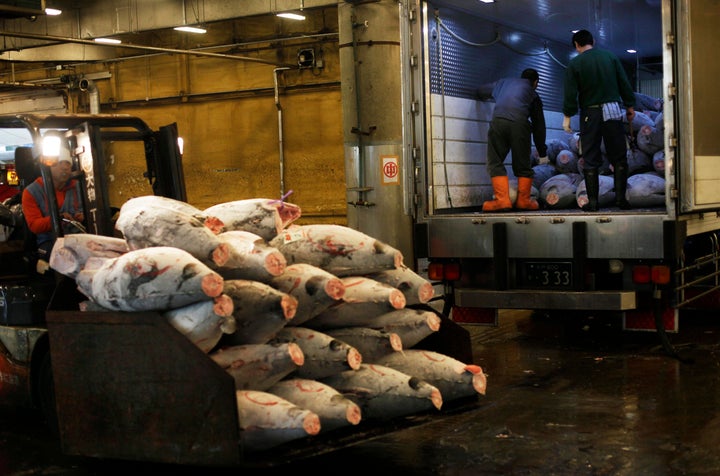
On May 27, the National Oceanic and Atmospheric Administration (NOAA) announced it won't list Atlantic bluefin tuna as endangered. (Note timing: a Friday before a 3-day holiday.)
The decision is understandable. The warm-blooded giant bluefin tuna can exceed half a ton and swim at highway speeds. Though also extremely large, the federal government is slower and colder. For the tuna, life would have been easier, perhaps even possible, if it were listed as endangered. For the government, life would have become a little more difficult. The decision was not up to the beleaguered bluefin, which lives by facts, not opinion.
The Atlantic bluefin tuna is not in imminent danger of extinction. Neither is the American buffalo; it's just demolished. Atlantic bluefin are, similarly, demolished. Officially bluefin are down 80 percent. But that's since the mid 1970s, when population estimates began. Yet back in the mid 1960s, commercial fishing boat operators were so alarmed by the decline in bluefin tuna that they themselves spearheaded forming the International Commission for the Conservation of Atlantic Tunas. And if you read accounts of bluefin tuna sport-fishing in the 1920s, it's easy to conclude that bluefin today are in the single-digit percentages of their former numbers. The schools of fish we used to see frothing the ocean's blue prairies in the 1980s are gone. The difference between the buffalo and the bluefin is that for the buffalo the main hunt is ended.
The bluefin is on a path to endangerment. And so we wait. One of the weaknesses of the Endangered Species Act is that it sets a floor -- preventing total extinction -- rather than setting a standard of abundant, viable populations. (By contrast, the Clean Water Act sets a standard: that America's waterways must be "fishable and swimmable.")
Lack of progress on bluefin rebuilding is frustrating. The tuna commission has been broken for decades. The original idea was that countries would come together to maintain populations of fish that they all relied on. In reality, each country seeks for itself the highest quota it can wrangle. And so things spiral.
The dearth of available procedural avenues sent conservationists to the Endangered Species Act. Yet even the Endangered Species Act could do little to control fishing by other countries when the fish migrate outside U.S. boundaries. This weakness is cited by U.S. fishermen opposing endangered listing (their main concern, of course, is to keep fishing). But endangered species status has greatly helped sea turtles and birds that cross out of U.S. air- and sea-space. That's because, for much of the year, they stay within areas controlled by the United States.
Similarly, the Endangered Species Act could have extended significant help to Atlantic bluefin tuna. There are two Atlantic bluefin breeding populations that don't interbreed, and the most depleted one breeds exclusively in the Gulf of Mexico. (The other breeds in the Mediterranean, where fishing is out of control. Individuals from both breeding stocks mix during migrations throughout the Atlantic.)
In the Gulf, federal rules limit how many spawning bluefin commercial fishing boats can keep. But commercial long-lines with hundreds of baited hooks targeting yellowfin tuna inevitably kill--then must discard--significant numbers of bluefin tuna. Because all bluefin they encounter in the Gulf are breeders from the deeply depleted west-Atlantic-stock, the Gulf is important. This month, the feds required Gulf longliners to use hooks designed to straighten under the strain of a giant bluefin. But they don't always work (see here). So the dwindling breeders remain at risk.
The right thing never happens for bluefin tuna. I've worked to persuade the tuna commission to lower catches. Fishing interests squashed us. We tried the international body that regulates wildlife trade -- and restricts things like elephant ivory, rhino horns, and cat skins -- to help bluefin. Fishing interests squashed us there, too -- and served bluefin at the meeting. Then we sued the U.S. government to at least close the Gulf of Mexico spawning areas during the spawning season. We lost.
So, after 20 years one comes to a certain inevitable conclusion: don't expect miracles; don't expect anything. And so, a new do-it-yourself effort, coordinated in part by Pew Charitable Trusts, is encouraging Gulf of Mexico longliners to voluntarily switch away from bluefin-killing longlines to a trolling technique and a tended-line method that would hook few, if any, bluefin tuna. The idea is: longliners would, in exchange for private money, agree to permanently change techniques. The conservationists would also work with national retailers to get them a premium price for a better, cleaner fish product. But NOAA has to officially sanction the deal. This time, they need to do the right thing.
